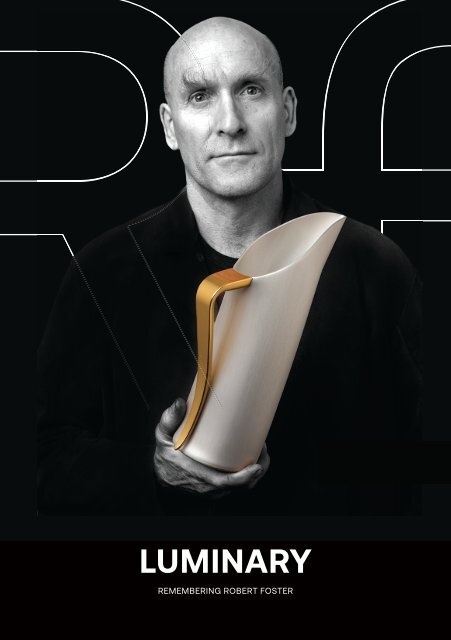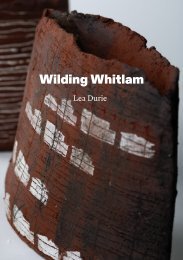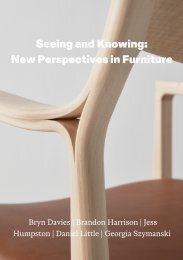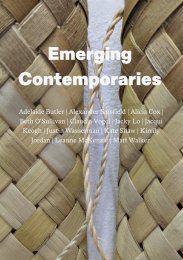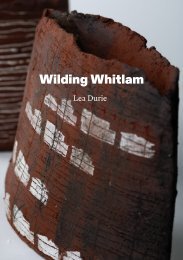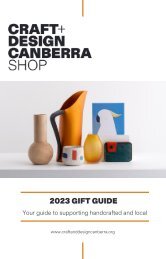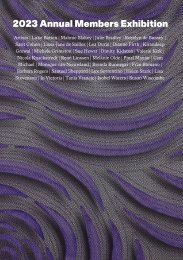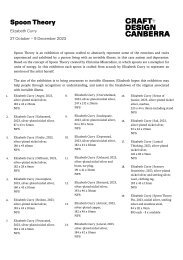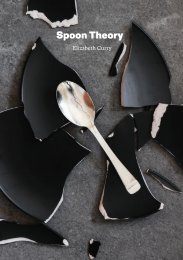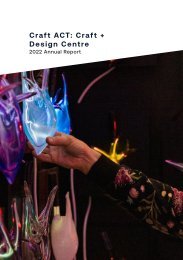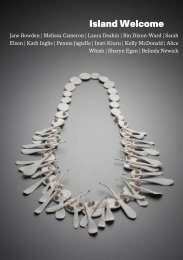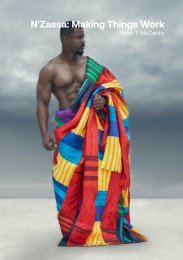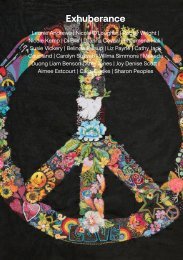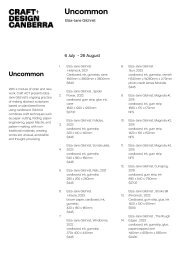Luminary: Remembering Robert Foster
Friends and colleagues from the ACT, across Australia and around the world, join Robert Foster’s family in remembering the extraordinary contribution this wonderful man made to our lives. Following the tragic accident that took his life on 13 July in 2016, Craft ACT offers a celebration, with affection and admiration, of his continuing influence as a luminary example, in every way. An imaginative and resourceful designer and maker working with metals and related materials, ‘Robbie’ (1962–2016) became well-known from the mid-1980s for his expressive and yet functional and exceptionally crafted hand-made forms, as well as for the innovative designs he developed for production through his company F!NK + Co, founded in 1994 and now operating in Queanbeyan. His many commissions include The Journey, a spectacular group of ‘ossolites’ installed in the foyer of ActewAGL headquarters, Canberra city, in 2010. Supported since 1997 by his enterprising partner, Gretel Harrison, and enthused by his daughters, Ineska and Mischa, Robert constantly experimented with ideas for new forms and processes. He believed strongly in the value of working between art and manufacture, fun and function, materials and processes, expression and sustainability. Luminary: Remembering Robert Foster is significant in that, apart from the now iconic F!NK Water Jugs,every work has been hand-made by Robert himself, as a one-off item or prototype for production. Craft ACT is especially grateful for the loan of all these unique works from the personal collection of his family. Robert also encouraged many emerging makers to work with him, and some evolved designs that were produced through the F!NK brand and identified with their names. They, and many others, acknowledge the importance of his generous mentorship in the development of their careers.
Friends and colleagues from the ACT, across Australia and around the world, join Robert Foster’s family in remembering the extraordinary contribution this wonderful man made to our lives. Following the tragic accident that took his life on 13 July in 2016, Craft ACT offers a celebration, with affection and admiration, of his continuing influence as a luminary example, in every way.
An imaginative and resourceful designer and maker working with metals and related materials, ‘Robbie’ (1962–2016) became well-known from the mid-1980s for his expressive and yet functional and exceptionally crafted hand-made forms, as well as for the innovative designs he developed for production through his company F!NK + Co, founded in 1994 and now operating in Queanbeyan. His many commissions include The Journey, a spectacular group of ‘ossolites’ installed in the foyer of ActewAGL headquarters, Canberra city, in 2010.
Supported since 1997 by his enterprising partner, Gretel Harrison, and enthused by his daughters, Ineska and Mischa, Robert constantly experimented with ideas for new forms and processes. He believed strongly in the value of working between art and manufacture, fun and function, materials and processes, expression and sustainability.
Luminary: Remembering Robert Foster is significant in that, apart from the now iconic F!NK Water Jugs,every work has been hand-made by Robert himself, as a one-off item or prototype for production. Craft ACT is especially grateful for the loan of all these unique works from the personal collection of his family.
Robert also encouraged many emerging makers to work with him, and some evolved designs that were produced through the F!NK brand and identified with their names. They, and many others, acknowledge the importance of his generous mentorship in the development of their careers.
You also want an ePaper? Increase the reach of your titles
YUMPU automatically turns print PDFs into web optimized ePapers that Google loves.
INVITATION<br />
LUMINARY<br />
REMEMBERING ROBERT FOSTER
LUMINARY<br />
REMEMBERING ROBERT FOSTER<br />
Craft ACT: Craft + Design Centre is supported by the ACT<br />
Government, the Visual Arts and Craft Strategy – an initiative<br />
of the Australian State and Territory Governments, and the<br />
Australia Council for the Arts – the Australian Government’s arts<br />
funding and advisory body.<br />
CRAFT ACT CRAFT + DESIGN CENTRE<br />
Tues–Fri 10am–5pm<br />
Saturdays 12–4pm<br />
Level 1, North Building, 180 London Circuit,<br />
Canberra ACT Australia<br />
+61 2 6262 9333<br />
www.craftact.org.au<br />
FINK & FRIENDS<br />
POP UP EXHIBITION | PAGE 37<br />
Cover: <strong>Luminary</strong> exhibition poster, designed by Lou Scrivener,<br />
photography by DMC Photography<br />
Page 4: <strong>Luminary</strong> exhibition, 2016. Photo: Edgelight Photography<br />
Craft ACT Craft + Design Centre<br />
31 October - 25 November 2016<br />
3
4 5
Craft ACT remembers <strong>Robert</strong> <strong>Foster</strong><br />
It was with the deepest regret and<br />
profound sadness that we learned of the<br />
passing of our friend <strong>Robert</strong> <strong>Foster</strong> in July<br />
2016.<br />
Robbie was an iconic designer and<br />
silversmith, and a mentor, collaborator,<br />
leader, supporter, inspiration, and teacher;<br />
but he was also a true friend to so many<br />
people in both our professional and<br />
personal communities here in Canberra.<br />
<strong>Robert</strong> had been a Craft ACT Accredited<br />
Professional Member since 1993.<br />
We were devastated that such a great<br />
man and talent was taken from us too<br />
early. We gained some comfort from the<br />
knowledge that his legacy would endure.<br />
Robbie’s contribution is great, both near<br />
and far. There is a <strong>Robert</strong> <strong>Foster</strong> F!NK<br />
jug in practically every second house in<br />
Canberra, yet his reach is international<br />
with sales in New York, London, Germany<br />
and beyond. He is revered and admired for<br />
his sculptural installations and exhibitions,<br />
and his work is held in major Australian<br />
and international collections.<br />
At Craft ACT, we wanted to celebrate<br />
<strong>Robert</strong>’s extraordinary contribution to<br />
contemporary craft and design, and<br />
our community. In our Civic gallery,<br />
we presented F!NK & Friends, which<br />
responded quickly and personally to the<br />
designer’s tragic passing. The F!NK &<br />
Co family, former associates of <strong>Robert</strong><br />
through his design practice, were invited<br />
to contribute an item that, for them,<br />
captured the spirit of <strong>Robert</strong>’s practice.<br />
Geoffrey Cossick, Chair of the UK Crafts<br />
Council, visited the exhibition and wrote<br />
in response, ‘it is when craft, making and<br />
memory come together that the power of<br />
an object can become so compelling’.<br />
As the centrepiece of the 2016 DESIGN<br />
Canberra festival, I commissioned<br />
<strong>Luminary</strong>: <strong>Remembering</strong> <strong>Robert</strong> <strong>Foster</strong>,<br />
curated by Grace Cochrane. It was<br />
the most visible and celebrated of the<br />
exhibitions in DESIGN Canberra for that<br />
year, and became the venue for the festival<br />
opening event and a number of artist talks.<br />
A celebration of the life and achievements<br />
of a local design icon, the exhibition<br />
encompassed <strong>Robert</strong>’s work, both from<br />
F!NK and from his personal collection. The<br />
exhibition was set among The Journey,<br />
his spectacular installation of ‘ossolites’<br />
in the headquarters of ActewAGL, which<br />
supported the exhibition together with<br />
Vince Frost. As well as the 49 pieces<br />
handmade by <strong>Robert</strong> from 1987 to 2016,<br />
the exhibition included 50 F!NK jugs that<br />
were loaned to the exhibition by members<br />
of the community.<br />
<strong>Robert</strong>’s legacy endures. F!NK, now<br />
spearheaded by his partner Gretel<br />
Harrison, remains a leader in our city’s<br />
art, craft and design landscape. F!NK was<br />
made a lifetime member of Craft ACT in<br />
2018, in recognition of their extraordinary<br />
support of the organisation and our<br />
community.<br />
I am delighted that as part of Craft<br />
ACT’s 50th anniversary, we are able to<br />
retrospectively produce this beautiful<br />
catalogue to record the two exhibitions<br />
curated in <strong>Robert</strong>’s honour in 2016.<br />
Rachael Coghlan<br />
CEO + Artistic Director<br />
Craft ACT: Craft + Design Centre<br />
April 2021<br />
Page 6: <strong>Luminary</strong> exhibition poster, designed by<br />
Lou Scrivener, photography by DMC Photography<br />
7
<strong>Luminary</strong>: <strong>Remembering</strong> <strong>Robert</strong> <strong>Foster</strong><br />
Exhibition essay: Grace Cochrane, curator<br />
Part 1: Introduction<br />
Friends and colleagues from the ACT,<br />
across Australia and around the world, join<br />
<strong>Robert</strong> <strong>Foster</strong>’s family in remembering the<br />
extraordinary contribution this wonderful<br />
man made to our lives. Following the<br />
tragic accident that took his life on 13 July<br />
in 2016, Craft ACT offers a celebration,<br />
with affection and admiration, of his<br />
continuing influence as a luminary<br />
example, in every way.<br />
An imaginative and resourceful designer<br />
and maker working with metals and<br />
related materials, ‘Robbie’ (1962–2016)<br />
became well-known from the mid-1980s<br />
for his expressive and yet functional and<br />
exceptionally crafted hand-made forms,<br />
as well as for the innovative designs he<br />
developed for production through his<br />
company F!NK + Co, founded in 1994 and<br />
now operating in Queanbeyan. His many<br />
commissions include The Journey, a<br />
spectacular group of ‘ossolites’ installed<br />
in the foyer of ActewAGL headquarters,<br />
Canberra city, in 2010.<br />
Supported since 1997 by his enterprising<br />
partner, Gretel Harrison, and enthused by<br />
his daughters, Ineska and Mischa, <strong>Robert</strong><br />
constantly experimented with ideas for<br />
new forms and processes. He believed<br />
strongly in the value of working between<br />
art and manufacture, fun and function,<br />
materials and processes, expression and<br />
sustainability.<br />
<strong>Luminary</strong>: <strong>Remembering</strong> <strong>Robert</strong> <strong>Foster</strong><br />
is significant in that, apart from the now<br />
iconic F!NK Water Jugs,every work has<br />
been hand-made by <strong>Robert</strong> himself, as a<br />
one-off item or prototype for production.<br />
Craft ACT is especially grateful for the<br />
loan of all these unique works from the<br />
personal collection of his family.<br />
<strong>Robert</strong> also encouraged many emerging<br />
makers to work with him, and some<br />
evolved designs that were produced<br />
through the F!NK brand and identified<br />
with their names. They, and many others,<br />
acknowledge the importance of his<br />
generous mentorship in the development<br />
of their careers.<br />
Page 8: <strong>Luminary</strong> exhibition, 2016. Photo:<br />
Edgelight Photography<br />
Page 10-11: <strong>Robert</strong> <strong>Foster</strong> created sculptural light<br />
forms called ossolites for the ActewAGL foyer in<br />
Canberra. Photo: Eddison Photographic Studio<br />
9
Part 2: <strong>Robert</strong> <strong>Foster</strong>: designing and<br />
making<br />
I don’t draw an ideological line between my<br />
one-off works and F!NK …I have learned<br />
to see them as notions of operation, that<br />
dwell on a sliding scale between objects<br />
only made possible via hand-making,<br />
through to the objects only made possible<br />
by manufacturing technology. (<strong>Robert</strong><br />
<strong>Foster</strong>, 2005)1<br />
<strong>Robert</strong> <strong>Foster</strong>’s designs have been<br />
described as imaginative interfaces<br />
between organic and geometric,<br />
expression and utility, personal and social.<br />
Influenced as a child in rural Victoria by<br />
his artistic and yet practical parents, and<br />
by teachers from Scandinavia and Europe<br />
at the Canberra School of Art (now ANU<br />
School of Art) in the 1980s, he soon<br />
developed a distinctive aesthetic.<br />
A resourceful experimenter, he soon<br />
became adept at working with aluminium<br />
tubes, reshaping them by also using<br />
processes including press-moulding,<br />
hydro-forming, thermo-forming and even<br />
explosives.<br />
Throughout, <strong>Robert</strong> was interested in<br />
polishing, powder-coating and, especially,<br />
anodising the metal surfaces, while<br />
incorporating materials such as rubber,<br />
acrylic and even snooker balls when the<br />
subject called for them. As well as the<br />
forging and pressing equipment that he<br />
installed in his workshop, he eventually<br />
established his own anodising unit to<br />
maintain oversight of the whole process of<br />
production<br />
He was also to extend his interest in<br />
vessel-making to designing furniture,<br />
lighting and jewellery.<br />
Central to his work in hollow-ware was a<br />
valuing of hand-made processes, such as<br />
the hammering required to hand-raise and<br />
form sheets of silver, stainless steel and<br />
aluminium into the shapes he sought.<br />
1. <strong>Robert</strong> <strong>Foster</strong>, in Vast Terrain: Design and<br />
Aluminium, FORM Gallery, Perth, 2005<br />
Page 12 + 14-15: <strong>Luminary</strong> exhibition, 2016.<br />
Photo: Madeline McGuigan<br />
13
Part 3: Teapots, coffeepots, jugs and<br />
jars<br />
The process of making results not so<br />
much from a deliberate state of mind but<br />
more from the result of serendipity … The<br />
predominant driving force whilst making<br />
is to discover an object that expresses a<br />
story, an emotion, or a sense of meaning.<br />
(<strong>Robert</strong> <strong>Foster</strong>, 1997)1<br />
<strong>Robert</strong> <strong>Foster</strong> valued the personal<br />
satisfaction of making individual pieces<br />
that could be regarded as the expressive<br />
edge of his wide spectrum of practice.<br />
His interests included responding to<br />
everyday activities such as drinking tea<br />
and coffee, and the way such habits bring<br />
people together, as well as the need for<br />
containers to hold items of value.<br />
From the outset he consistently made<br />
unique hand-formed teapots that he saw<br />
as personal artwork and which did not<br />
go into production. Working around the<br />
necessary components of containers,<br />
lids, spouts and handles in new visual<br />
and functional relationships, he often<br />
integrated imaginative metaphorical<br />
references to creatures such as scorpions,<br />
raccoons, turtles and stingrays, as well<br />
as characters from the Dr Seuss books<br />
belonging to his daughters.<br />
He liked to be free of prescriptive<br />
design conventions, and valued a<br />
playful approach to serious creative<br />
experimentation: the form of Bye Bye<br />
Brontosaurus, for example, refers to<br />
dinosaur eggs. Jugs and other containers<br />
such as vessels and vases were also<br />
among <strong>Robert</strong>’s continuing passions.<br />
Some were designed to be easily lifted<br />
without a handle; on others the handle<br />
contributes to the overall design profile as<br />
well as being a functional component.<br />
Vessels might be hand-raised or formed,<br />
or press-forged under hydraulic pressure.<br />
For some, the starting point could be a<br />
tube, rather than a sheet of metal, while<br />
to put some of his hand-made prototypes<br />
into production, he introduced more<br />
complex technologies, including pressforming,<br />
water-forming and thermoforming.<br />
1. <strong>Robert</strong> <strong>Foster</strong>, in Rhana Devenport,<br />
Contemporary Vessels and Jewellery, QAG, 1997<br />
Page 16 + 18-19: <strong>Luminary</strong> exhibition, 2016.<br />
Photo: Madeline McGuigan<br />
17
18 19
Part 4: Presenting, containing, wearing<br />
As the shape of the metal changes, I begin<br />
to see the choices and possibilities of how<br />
to manipulate the material next. In a way<br />
it is like drawing with the hammer. (<strong>Robert</strong><br />
<strong>Foster</strong>, 1997)1<br />
Platters and trays<br />
Reflecting his interest in the natural world,<br />
<strong>Robert</strong> <strong>Foster</strong>’s sculptural ideas also took<br />
form in a number of trays, some of which<br />
resemble waves or glaciers —evoking<br />
images of curling and rippling, slipping and<br />
sliding. For these he used a press-forging<br />
process as well as hand-finishing, to make<br />
both the forms and the patterns in their<br />
surfaces.<br />
much to be used as carriers for personal<br />
possessions.<br />
In the 2000s, following the release of<br />
iPod pocket computers, <strong>Robert</strong> made a<br />
series of Hipod carrying containers in the<br />
familiar shape of a computer mouse, to be<br />
worn on a belt or slipped into a pocket. As<br />
always, he innovatively combined function<br />
with metaphorical meaning.<br />
Handbags and Hipods<br />
Many of <strong>Robert</strong>’s designs made reference<br />
to the form of the body, acknowledging<br />
perhaps, that vessels are often described<br />
as having bellies, feet, waists, necks and<br />
shoulders.<br />
It may not be surprising then, that beyond<br />
vessels to be used on the table, he also<br />
made innovative carrying containers.<br />
While his Handbag teapots of 1995<br />
presented a dual meaning and function,<br />
later handbags and toolboxes were very<br />
1. <strong>Robert</strong> <strong>Foster</strong>, in Rhana Devenport,<br />
Contemporary Vessels and Jewellery, QAG, 1997<br />
Page 20: DESIGN Canberra 2016, VIP opening.<br />
Photo: Edgelight Photography<br />
Page 22-23: <strong>Luminary</strong> exhibition, 2016. Photo:<br />
Madeline McGuigan<br />
21
22 23
Part 5: The F!NK Water Jug<br />
An exciting opportunity with long-reaching<br />
consequences came in 1993 when <strong>Robert</strong><br />
<strong>Foster</strong> was commissioned to make a<br />
limited edition water jug for the opening of<br />
the Republic, a new Canberra restaurant.<br />
Initially hand-formed using a simple press<br />
that he made himself, the F!NK Water Jug<br />
became the first product of what was to<br />
become his limited-run manufacturing<br />
company F!NK+Co. from 1994. The jug<br />
remains a signature piece for the company<br />
and, in different anodised matt colours<br />
as well as a silver satin finish, is sold to<br />
enthusiastic clients around the world.<br />
Similarly, as he experimented further with<br />
different forming processes and carried<br />
out his own anodising, others of <strong>Robert</strong>’s<br />
hand-made pieces were to serve as<br />
prototypes for production by employees<br />
in F!NK+Co. These include beakers, trays,<br />
bowls, items of jewellery and components<br />
for lighting and other commissioned<br />
works.<br />
<strong>Robert</strong> also provided well-remembered<br />
collaborative opportunities for many<br />
young designers to work on the F!NK<br />
range.<br />
It encapsulates the qualities of F!NK+Co.<br />
that have distinguished it since it was<br />
established in 1994: distinctive design,<br />
rethinking function and technical<br />
innovation. (Merryn Gates) 1<br />
Rohan Nicol explains that for the first<br />
edition in 1993: ‘there were several<br />
pressings with different moulds: one for<br />
the flared base, one for the beak and one<br />
for the shoulder’. <strong>Robert</strong> then introduced<br />
a more sophisticated press, where only<br />
one pressing was necessary, before final<br />
hand-finishing.<br />
1. Merryn Gates, ‘<strong>Foster</strong>ing Design: Drawing On a<br />
Pool of Raw Talent’, Object Magazine, Issue 49,<br />
2006<br />
Page 24: <strong>Luminary</strong> exhibition, 2016. Photo:<br />
Madeline McGuigan<br />
25
List of works<br />
Teapots 1987-1991 Teapots 1991-1998 Teapots 2002-2010<br />
Platters 2011<br />
1 Mouse teapot, 1987-89<br />
Aluminium, handraised and<br />
powder-coated, anodised<br />
aluminium handle, 13 x 20x<br />
14<br />
7 Snow teapot, 1992<br />
Aluminium, handraised and<br />
powder coated, anodised,<br />
17 x 20 x 6<br />
13 Stingray teapot, 2002<br />
Aluminium, handraised and<br />
anodised<br />
18 Green Wake, 2011<br />
Aluminium, press forged<br />
and anodised<br />
2 Baby Elly teapot, 1991<br />
Aluminium, handraised,<br />
epoxy coated and anodised,<br />
22 x 25 x 6<br />
8 Teapot, 1995<br />
Aluminium, handraised and<br />
anodised, 11 x 19 x 13<br />
14 Scorpion teapot, 2004<br />
Stainless steel, handformed<br />
and anodised, with<br />
perforated aluminium, 20 x<br />
15.5 x 17.5<br />
19 Blue Tsunami, 2011<br />
Aluminium, press forged<br />
and anodised<br />
3 Pingko teapot, 1991<br />
Aluminium, handraised and<br />
powder coated, anodised<br />
aluminium handle, snooker<br />
ball, 19 x 19 x 8<br />
9 Snout teapot, 1991<br />
Aluminium, handraaised<br />
and powder coated,<br />
anodised aluminium, 20 x<br />
19 x 13<br />
15 Black Raider teapot,<br />
2008, Aluminium,<br />
hydroformed, fabricated<br />
and anodised, acrylic, 18 x<br />
20 x 22<br />
4 Lovegun teapot, 1991<br />
Stainless steel, handformed<br />
and powder coated,<br />
anodised aluminium, 16 x<br />
22 x 15<br />
10 Handbag teapot, 1995<br />
Stainless steel, handformed,<br />
with anodised aluminium,<br />
snooker ball, 20 x 25 x 4<br />
16 Mr Giggles teapot, 2009<br />
Aluminium, handraised and<br />
anodised, 14 x 8 x 10<br />
5 Teapot, 1991<br />
Aluminium, handraised and<br />
anodised, 16 x 36 (32)<br />
11 Teapot, 1996<br />
Steel, handformed and<br />
blackened, with anodised<br />
aluminium, 16 x 15 x 15<br />
17 Amoeba teapot, 2010<br />
Stainless steel, handformed,<br />
with anodised aluminium,<br />
acrylic, 16 x 22 x 15<br />
6 Teapot, 1991<br />
Aluminium, handraised and<br />
powder coated, perforated<br />
aluminium, 6 x 18 x 12<br />
12 Teapot, 1998<br />
Stainless steel,<br />
handformed and blackened,<br />
with anodised aluminium,<br />
Delrin, 12 x 15 x 14<br />
26 27
List of works<br />
Hanbags and Hipods<br />
Coffee pots<br />
Jugs and vase 1980s-90s<br />
20 Boys Toolbox, 2004<br />
Aluminium, hand formed<br />
and anodised, acrylic, 18 x<br />
12 x 9<br />
26 Hipod, 2009<br />
Stainless steel,<br />
handformed, with anodised<br />
aluminium, 6 x 19 x 10<br />
28 Coffee pot, 1991<br />
Aluminium, handformed and<br />
anodised, 23 x 10 x 9<br />
33 Whale jug, 1988<br />
Aluminium, handraised and<br />
anodised, granite<br />
21 Girl’s Own Toolbox,<br />
2004, Aluminium, hand<br />
formed and anodised,<br />
acrylic, 24 x 20 x 10<br />
27 Hipod, 2009<br />
Stainless steel,<br />
handformed, with acrylic, 5<br />
x 18 x 9<br />
29 Coffee pot, 1998<br />
Stainless steel, perforated<br />
aluminium, handformed<br />
25 x 18 x 8<br />
34 Jug, 1988<br />
Aluminium, handraised<br />
and anodised, slate, 25 x<br />
20 x 11<br />
22 Blue Ether, handbag,<br />
2001, Aluminium,<br />
hydroformed and anodised,<br />
with stainless steel handle,<br />
plastic, rubber, 28 x 11 x 32<br />
30 Swan coffee pot, 1999<br />
Steel, handformed and<br />
blackened, with perforated<br />
aluminium, 28 x 17 x 5<br />
35 Vase, 1988<br />
Aluminium, handraised and<br />
anodised, 25 x 16 x 9<br />
23 Oyster Hipod, 2000<br />
Stainless steel, handformed,<br />
with rubber, neoprene<br />
3 x 13 x 9<br />
31 Coffeepot, prototype 1,<br />
2010, Aluminium, handraised<br />
and anodised, plastic,<br />
24 x 12 x 8<br />
36 Jug, 1991<br />
Aluminium, handraised and<br />
anodised, snooker ball, 26<br />
x 9 x 8<br />
24 Hipod, 2000<br />
Aluminium, perforated,<br />
handformed with stainless<br />
steel, rubber, 4 x 16 x 8<br />
32 Coffeepot, prototype<br />
2, 2014, Stainless steel,<br />
handformed, with anodised<br />
aluminium, 28 x 18 x 12<br />
37 Jug, 1991<br />
Aluminium, handraised and<br />
anodised, 21 x 17 x 9<br />
25 Hipod, 2000<br />
Stainless steel, handformed,<br />
with rubber, neoprene<br />
4 x 12 x 8<br />
28 29
List of works<br />
Vases and containers<br />
Vases 2001 - 2010<br />
F!NK Water Jugs<br />
38 Trio of vessels, 1996<br />
Steel, handformed and<br />
blackened, anodised<br />
aluminium, 24 x 11 x 6, 17 x<br />
10 x 4, 12 x 10 x 5<br />
42 Valkyrie vase, 2001<br />
Stainless steel,<br />
handformed, with anodised<br />
aluminium, 40 x 28x 5<br />
47 The F!NK Water<br />
Jug, designed 1993, in<br />
continuous production<br />
since 1994. Press formed<br />
aluminium, anodised,<br />
powder-coated handle.<br />
Approx. 30 x 18 x 10<br />
39 Vases, 10, 12, 14, 1996<br />
Aluminium tube, hand<br />
hammered and anodised.<br />
Prototypes for later F!NK<br />
Explosive vases, 28 x 13 x 6;<br />
29 x 13 x 6; 30 x 13 x 7<br />
43 Edinburgh vase, 2008<br />
Aluminium, press forged<br />
and handformed, anodised,<br />
37 x 14 x 14<br />
40 Vessel, 2005<br />
Aluminium, handformed and<br />
anodised, sandblasted, 32 x<br />
11 x 11<br />
44 Pewter Expulsion vase,<br />
2009, Aluminium, press<br />
forged and handformed,<br />
anodised, 40 x 20 x 20<br />
41 Vessel, 2006<br />
Aluminium tube,<br />
handformed and anodised,<br />
33 x 9 x 8<br />
45 Bye Bye Stegosaurus,<br />
vessel, 2010, Aluminium,<br />
press forged and<br />
handformed, anodised, 27<br />
x 13 x 13<br />
46 Bye bye, Brontosaurus,<br />
2010, Aluminium, press<br />
forged and handformed,<br />
anodised, 18 x 11 x 11<br />
30 31
32 33
34 35
FiNK & Friends: Pop up exhibition<br />
21 July - 3 September 2016<br />
Craft ACT was honoured to host a popup<br />
exhibition in the lightbox gallery of<br />
personal items on loan from the F!NK + Co<br />
extended family of Robbie <strong>Foster</strong>.<br />
Thank you to all who shared memories<br />
and tributes in the condolence book during<br />
their visit and via email.<br />
Descriptions of personal items on loan,<br />
as told by the F!NK + Co. extended family<br />
1. Dan Lorrimer<br />
Taken out of deep storage, this<br />
“hydroforming” tool was made with<br />
Robbie for Dan’s Centenary of Canberra<br />
production line of platters. As well as this<br />
tool, Robbie helped Dan solve a range of<br />
problems which meant that the platters<br />
could be made – consistently and to a<br />
high quality. Dan’s hammer symbolises<br />
advice often given by Robbie: “You are<br />
not a metal worker until you have made a<br />
hammer.”<br />
2. The F!NK + Co crew<br />
Robbie always had a container of nuts in<br />
the F!NK workshop for people to share.<br />
This Squash Container contains his most<br />
recent nut stash.<br />
3. Sean Booth<br />
This hammer was made during an<br />
AustraliaCouncil Mentorship program<br />
where Robbie mentored Sean, an early<br />
career silversmith at the time. Sean was<br />
preparing to set up his own studio so<br />
Robbie encouraged him to make some<br />
tools, including this hammer. The teapot<br />
was a birthday gift from Robbie.<br />
4. Janel Laza<br />
Janel received this special heart from<br />
Robbie when she was having a particularly<br />
rough day. She was having relationship<br />
issues, was home sick, and bummed<br />
out. Robbie handed her the heart, gave<br />
her the “biggest and most amazing<br />
Robbie hug” and shared warm words of<br />
encouragement. “He gave me some love in<br />
hugs and metal form,” says Janel.<br />
5. Darren Chong<br />
Robbie gave Darren this shiny purple<br />
jug as a gift after the first time they<br />
successfully “bright-dipped” (polished and<br />
coloured) a F!NK + Co jug.<br />
Page 36: FiNK & Friends exhibition, 2016. Photo:<br />
Craft ACT<br />
Page 37: FiNK & Friends exhibition, 2016. Photo:<br />
Craft ACT<br />
36 37
38 39
6. Gretel Harrison<br />
Robbie and Gretel made three belts<br />
together: one for Gretel; and one for each<br />
of their fathers. These belts were made to<br />
bond their families together.<br />
7. Gretel Harrison<br />
Robbie gave Gretel this perfume bottle<br />
for their first Christmas together, 23 years<br />
ago. The bangle was a gift from last<br />
Christmas.<br />
8. Louise Scrivener<br />
Louise is Fink and Co.’s graphic designer<br />
and this brooch is the result of a<br />
collaboration between Robbie and Louise.<br />
Together, they designed and made this<br />
piece of jewellery for a pop-up typography<br />
exhibition, based on the “F” from Fink.<br />
9. Kim Berry<br />
Robbie hand poured this silver ring which<br />
was cast in a paper mould, floating on<br />
water. Robbie invited Kim to watch the<br />
process, but he hadn’t told her the ring<br />
was going to be her birthday gift. Robbie<br />
made the bangle for Kim as a parting gift<br />
when she left her full-time position at<br />
F!NK. Kim was pregnant at the time and at<br />
first, she remembers, it was a very tight fit.<br />
and fabrication skills. Every year, Robbie<br />
and Gretel give a F!NK + Co. product of<br />
choice to their staff. Bengt chose this<br />
light which, at the time, was unassembled<br />
with various parts located throughout the<br />
F!NK workshop. Bengt remembers that<br />
Robbie might have been mildly irritated<br />
by his request, but Robbie found and gave<br />
the various components of the light to<br />
Bengt anyway. Bengt assembled the light<br />
especially for this pop-up exhibition.<br />
11. Alison Jackson<br />
Robbie hosted forging parties out the back<br />
of F!NK on special weekends. Silversmiths,<br />
buddies and people who wanted to dig in<br />
and have a go were all invited. Everyone<br />
would come together to make pieces.<br />
On one of these weekends Alison made<br />
silversmithing hammers, and Alison<br />
remembers Robbie’s encouragement<br />
for her to keep pursuing the craft of<br />
silversmithing.<br />
12. Danilo Enders-Moje<br />
The bandolier “utility belt” was one of<br />
many objects lying around Robbie’s<br />
workshop. During a workshop clean up,<br />
the utility belt was going to be thrown<br />
away. Danilo asked if he could keep the<br />
belt, and of course Robbie obliged.<br />
10. Bengt Cannon<br />
Robbie’s artistic, making and design skills Page 40: FiNK & Friends exhibition, 2016. Photo:<br />
have been supported over the years by<br />
Craft ACT<br />
Page 42-43: FiNK & Friends exhibition, 2016.<br />
long-time employee Bengt’s production<br />
Photo: Craft ACT<br />
Page 44-45: FiNK & Friends exhibition, 2016.<br />
Photo: Art Atelier Photography<br />
40 41
42 43
44 45


